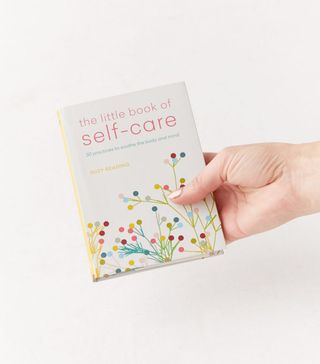It's So Important to Set Healthy Boundaries—Here's How to Get Started

Boundaries. We know they're important, but they can be a complicated, loaded subject. Everyone has different boundaries or limits and different ways of expressing or sticking to them. Some of us have them, but we may not be so good at enforcing them. And others might not understand what they are exactly.
"A boundary is a rule or limit created to reinforce safety, comfort, and/or personal space," explains Brittney Cobb, MSW, LCSW, founder of Be Well Mental Health & Consulting Services. "Boundaries are necessary in all relationships. They help people understand what behaviors are and are not acceptable. Healthy boundaries can never be harmful, but they can reveal the types of relationships you have with people."
There are some drawbacks to them, too, and they can depend on how strict or lax they are. "In terms of how they can be harmful, sometimes if boundaries are either too rigid or too loose, they can lead to strained relationships," says Madeleine DiLeonardo, MEd, LPC, NCC, CCATP, a licensed professional counselor and founder of Mind Body and Soul by DiLeonardo Wellness. "Sometimes, the word 'boundaries' is met with a negative perception, but the healthier your boundaries are, the healthier your relationships can be! They allow for positive relationships, sustaining emotional energy, and giving you space to grow."
So yes, we do need boundaries in our lives. At work, they can help us create work-life balance. In relationships, they can build stronger bonds. With ourselves, they allow us to know our own limits. All of that sounds so good and helpful, but the act of deciding what they really are and how to live with them can be tricky. We might feel guilt for putting them up, or we could have uncertainty about what we actually want. Simply put, a lot of feelings can come into play.
It might seem daunting, but it just takes some work to sort through your needs and figure out how you're going to put them into place. To help, we asked therapists to share their tips and strategies so that you can get started or reset the existing boundaries that aren't serving you.
General Rules for Setting and Sticking to Your Boundaries
1. Focus on Your Values

First, you should know what your priorities, goals, and needs are. Having that knowledge will help you clarify and explain your boundaries. You'll be able to create boundaries that support your values. "It's almost like when you're programming a computer: You don't just set the rule without figuring out what program you're using or why you're doing it. You need to know what exactly you're doing before you set the rule around what it needs to do," says Meghan Watson, MA, registered psychotherapist and managing director at Bloom Psychology & Wellness.
2. Ask Yourself These Questions

You might not know where to start or what kinds of boundaries you need in your relationships, at work, on social media, etc. It helps to do some introspection and ask yourself some questions. "Once you start to ask yourself these questions, you can have a better idea of what your boundaries need to be and who you need to set them with," says Jordan Madison, LCMFT, creator of Therapy Is My JAM. Here are some prompts:
-What do I need?
-When it comes to my jobs, relationships, and time, what do I enjoy?
-What do I enjoy that I still do? Why is that?
-Who do I find it hard to set boundaries with? What holds me back from sticking to the boundaries I set?
-What do I feel obligated to do related to friends, family, and work that I truly don't want to do?
-Does what I'm saying yes to align with my values?
-When saying yes, we are inevitably saying no to something. Is this the right time to say yes?
3. Notice Your Emotions

"It's important to pay close attention to your energy and how you feel around certain people," Cobb says. "Identify behaviors that make you feel uncomfortable. Also, figure out what makes you happy. Knowing what you need, like, and dislike will help you create a starting place for setting boundaries. Recognize that the way others feel is not more important than you honoring your own feelings."
4. Have a Policy

Creating a policy, or policies, may get you to stick to your boundaries. Watson says that keeping in mind that your boundaries are yours and no one else's is helpful because it gets you in the mindset that this is what you want to do and how you want to live your life in relation to others. That doesn't mean you can't be flexible, though.
"A policy is like a technique that I often teach to clients," Watson says. "It's like a gift. For example, 'I have a policy of not taking Zoom meetings after 7:00 PM' This adds seriousness to the situation. It implies thoughtfulness to the boundary. It conveys commitments that you can't break. Another example would be, 'Sorry, I can't come. It's our policy to have family dinner every Wednesday night.' This lets the other person know the value of your family ritual, and it takes away the personalness from setting that boundary."
5. Communicate With Intent

You'll want to be extra mindful of how you communicate your boundaries. "Open communication and using 'I' statements is helpful for this," DiLeonardo says. "Continue to calmly and directly communicate how you feel, and model how you would like to be treated by others. Ironically, if someone does not have clear boundaries, they are likely going to be upset that you are trying to establish boundaries with them. Remember that their response should not dictate whether you make changes to your boundaries, and you are not responsible for other people's feelings."
Using "I" statements can help you be assertive, Cobb adds. That term can have a negative connotation sometimes, like you're being "bossy" or "brash," but that's not the case, especially when you're phrasing it in a certain way. "Assertiveness is the ability to communicate your wants, needs, and feelings while also taking into consideration the wants, needs, and feelings of other people," Cobb says. "An example could be, 'When you raise your voice, I don't feel heard. What I would like for you to do is speak calmly. If you cannot do this, we will not be able to have a discussion at this moment.' You've communicated your feelings, what you would like to see happen, and what will happen if your boundary is not respected."
6. Remember, No Is a Complete Sentence

This can be a powerful concept. "The thing about relationships and boundaries is that 'No' is a complete sentence," Watson says. "And you don't have to over-justify or overexplain why you're setting a limit that works for you. They have every right and opportunity to set their own limits, but you don't have to overexplain."
Using absolute words like yes or no will ensure that you're expressing things clearly and doesn't leave room for interpretation, adds writer, speaker, and therapist Minaa B., LMSW. But if you do feel that you want to provide some context, keep it simple. "It can look like, 'No, I can't make it to your event tonight. Unfortunately, I don't have time in my schedule,' instead of, 'I am not sure if I can come tonight because I have to work on emails then prepare dinner for the kids and do their bedtime routine.' The reality is the answer is still no, you are not showing up. There's no need to overexplain yourself when all the person on the receiving end is going to hear is no," she says.
7. Don't Dilute the Message

Like we can overexplain, we can also use certain language to add what we think is levity or softness to the situation because we don't want to offend someone or seem too forceful. You'll just be causing even more confusion. "This could be adding sarcasm or starting a boundary with, 'You might not care but…' or ending it with 'nevermind,'" Cobb says. "This is passive-aggressive. When your boundary is unclear or full of unnecessary fillers, it defeats the purpose. People cannot read our minds. They cannot guess what we need. They will not respect our boundaries if we do not communicate assertively."
8. You Can Leave the Door Ajar or Closed

Watson uses the metaphor of "Door ajar, door closed" with boundaries. "Sometimes you can leave the door ajar if you don't want to be totally firm with that boundary," she says. "You can say, 'Hey, I don't have time today. I'm going to check back with you on what my availability looks like for supporting you with this.' And if they follow up with you and they say like, 'No, I really need you to help me. You're so good at it,' then you can say, 'I've actually just checked my calendar, and I just don't have the space. I'm not able to help you.' Door closed."
9. Accept Your Boundaries

You have to be comfortable with your own boundaries in order to enforce them. "I think the tendency to want to smooth things over is motivated by our discomfort with our own boundaries," Watson says. "So it really isn't about the other person at this point. It's about us. We need to challenge ourselves to be okay with this limit because if we're not, we're going to feel stressed and worried about what people are going to think, whether or not they're going to react to it, and we will get caught up in the story of, 'This isn't worth it anyway.' And that story is a lie that keeps you from not living the life that you want."
This will also help you come to terms with any guilt you might experience.
10. Be Flexible

While you want to be assertive with your boundaries, it's okay to allow for some flexibility, too. Using "all or nothing" language about behaviors like, "I will always do that" or "You should never do that" is a common misstep, DiLeonardo says. "Additionally, having too rigid of boundaries is not helpful, as we want to remember that life ebbs and flows and our boundaries can shift as this happens. We want to be flexible in our boundaries and consistently give ourselves space to reevaluate," she explains.
And Cobb advises allowing some grace in these situations, as not everyone will get your boundary right the first time. It's up to you to determine second chances.
11. Don't Rely on Threats or Ultimatums

"This could be allowing someone to break your boundary multiple times," Cobb explains. "It might be threatening someone with a boundary but not following through or demanding someone to do something without communicating it in a healthy way."
How to Set Boundaries at Work
While all of the general advice above applies to most situations, there are some specific strategies that are more helpful in the workplace. Of course, all of this depends on your specific work environment, so take that into account as you're reading these tips.
1. Understand What Your Role Is

"Know your job responsibilities and your limits while allowing some flexibility," Cobb recommends. "Create a structured routine if possible. Know when to delegate responsibility. Understand when to ask for help. Say no when your plate is full, and do not overcommit yourself to tasks because you will become burnt out."
2. Say No and Yes

Okay. That phrase might seem confusing, so let us explain: Saying no to something also means you're saying yes to something. Let's say you're in a scenario where your boss is emailing you late at night. Watson says you should approach them with something like, "I got an email from you really late last night. I happened to be up to see it. I tend to be sleeping during those times, and I really value your connection and your responsiveness to me. I want to be able to support you. Is there another way that we can communicate around ideas, priorities, and deliverables that might be more supportive to both of our habits and ways of working?"
You're essentially saying yes, you want to get their emails but no, you don't want to get them at that time. "Asking yourself the question of 'What am I saying yes to?' is really important because saying no to something also means saying yes to something else," Watson says. "What am I making more room for when I set this limit? What would be helpful for me in the future when I maintain this boundary, this limit, this line? And what am I opening myself up to when I put that as nonnegotiable?"
3. Take Stock of Your Emotions

If you're ready to approach your supervisor or colleague about your boundaries, make sure to come with a clear head and to keep your emotions in check so you can get your point across. "If you're not feeling well—you're feeling a little unstable, stressed, and overwhelmed—that might not be the best time to have that conversation with your boss. Do some of your own work first, then show up to the office," Watson says.
Also, be honest about your bandwidth and keep an open line of communication.
4. Keep Work Relationships Professional

"This is at your discretion, but when professional relationships turn personal, sometimes roles can become convoluted. I think there can be balance between both personal and professional," Cobb says.
5. Take Time Off

We all need a mental health day or some vacation time to avoid burnout and for better work-life balance. Listen to your body and mind when they're telling you that you need a break.
6. Designate a Specific Area for Work

This is especially helpful if you work from home, which a lot of people are doing right now. The lines between work and personal life can get fuzzy. "Rather than waking up and hopping right on the computer or being available for email communication late into the evening, we want to establish a boundary between our work and our home life," DiLeonardo says. "For some people, this means designating a specific area of your living space for work and only working in this space or ensuring that you log off around the same time every evening and have something planned that signifies the end of the workday, such as going for a walk or taking a shower."
How to Set Boundaries in Relationships
Boundaries in relationships can differ depending on the type: romantic, platonic, familial, etc. But having some no matter the type can lead to healthier partnerships and ties.
1. Identify Emotions

When thinking about your relationships with others, it can be helpful to pay attention to what you're feeling. "I think noticing when certain emotions come up, such as resentment, anger, guilt, and shame, and identifying and labeling those are really important to starting to set those boundaries because those are the emotions that are often associated when your limits are being crossed, or you don't have a boundary where you need one," Watson says.
2. Set Different Types of Boundaries

DiLeonardo says you can set boundaries for things like time, energy, emotions, personal space, and possessions. "Setting boundaries in relationships can include things like how quickly or regularly you can respond to messages, how available you are for plans, topics of conversation you are comfortable with, and what people you have relationships with can realistically expect from you," she explains. "Being clear with friends, family members, and partners about what you want and need, as well as what you can offer them and what your limits are, is part of establishing healthy relationships."
3. Rethink Relationships

"The goal should be to communicate in an effective way, and if relationships are damaged because of your boundaries, it may be a sign you need to reevaluate the relationship," Cobb says. "When communicating your boundaries, it is less about damaging the relationship and more about honoring your needs."
How to Set Boundaries With Yourself
"Setting boundaries with yourself is important, too. They help you stay accountable. Without them, you can really do some damage to your goals and your aspirations without even knowing it because you're not setting appropriate boundaries to get things done," Watson says.
1. Name the Story

Basically, what's your excuse for neglecting your boundaries? "Naming the story you tell yourself around not keeping your own promises with your own boundaries is really important," Watson says. "For example, the 'I'll have more time later' or 'I'm too tired to do something for me' or 'I don't deserve a break today' stories. Where did those stories come from? What's the origin? Can you identify a more helpful script? What will you gain by holding yourself accountable to the habits that help?"
Being self-aware and determining what you value can also help you establish boundaries with yourself, DiLeonardo adds.
2. Practice Prevention

"Prevention is really important and about not putting yourself in situations where people have access to your boundaries when they don't need them," Watson says. She gives the example of not letting someone like your mom know when you are taking an uninterrupted day off to yourself since she might want to join you on your solo day.
3. Keep a Schedule

This can be helpful when it comes to your own bandwidth. Madison suggests implementing a screen time limit or turning on Do Not Disturb mode on your phone.
4. Treat Yourself Well

Be kind to yourself and practice self-care. "If you wouldn't ignore a boundary that someone else sets, why aren't you honoring your own?" DiLeonardo says. "I would also add that codependency stems from neglecting our own boundaries, prioritizing others, and minimizing our own desires in order to please others, which is a disservice both to ourselves and the other person."
5. Have Someone to Hold You Accountable

You can share some of your personal boundaries with others so they can call you out when you've forgotten about them. "Remind yourself of the goal and why your boundaries are essential to helping you get there. Focus on the biggest picture," Madison says.
How to Set Boundaries With Social Media
Spending a lot of time on social media can be so draining. It can mess with your self-esteem, anxiety, relationships, and more. And since many of us are pretty much glued to our phones, it can be beneficial to take a step back and create some boundaries there.
1. Have Alternative Methods of Communication

Don't rely on social media to connect with your friends or family. "My biggest tip is to make sure that you have alternatives that get exactly what you asked for. So if I know that I want to stay in touch with my friends, do they have texting? Can I text them? Okay, that's going to be my avenue," Watson says. "And my boundary is that I'm not going to slide into their Instagram DMs. I'm not going to send them an email. I'm going to text them because that allows me the opportunity to connect with them personally."
2. Don't Be Afraid to Delete the App

Delete the app or log off if you need a break. If you're too attached to do either, Cobb suggests unfollowing or unfriending accounts that spew negativity or that don't make you happy and/or turning off notifications for a specific time or altogether.
You can also put some physical distance between you and your phone, DiLeonardo recommends, like putting it in another room or in a drawer.
3. Schedule "Worry" Time

Yes, you read that right. "This is a trick for serious anxiety, but it also helps with the news because a lot of our news is really worrying and stressful," Watson says. "Schedule worry time. Schedule news time. Ideally, not when you're beginning your day or ending your day. If you have a bit of a lunch break or 15 minutes between meetings, schedule your news time, and get to it. Plan to listen to yourself when the alarm goes off to say it's done."
You might feel the need to be caught up on every piece of news, but Watson advises freeing yourself from that burden. You'll find out the need-to-know stuff from someone else or during your next news time.
4. Ask Yourself What It's Doing for You

"If you find yourself mindlessly looking online, ask yourself, 'How is this serving me?'" DiLeonardo suggests. "Often, we are scrolling out of boredom or because this has become so routine, but it is not actually something healthy for us or even something we want to be doing."
How to Respect Others' Boundaries
It's a two-way street. If you want someone to respect your boundaries, you have to respect theirs, too. Here are some things to keep in mind:
Understand you will make mistakes: You might forget others' boundaries because they're not in your forefront. "Respect them when they say no. Listen to their response," Watson says. "Manage your feelings around what that means for you and the meaning you're ascribing to their no. And let them know that you respect them and you are thankful for them sharing something that vulnerable with you because being boundaried is being vulnerable."
Take responsibility for your feelings: This is a big part of respecting other people's boundaries, DiLeonardo says. "We are always responsible for how we feel and our decisions and behavior, and this responsibility should not be placed on another person," she adds.
Listen: The best thing you can start with is listening. "When people healthy set boundaries with you, it is because they want to maintain a meaningful relationship, not push you away. Listen when people tell you what they expect, how they feel, and why," Cobb says.
Next up: The Daily Mental Health Habit That Makes a Big Difference
Disclaimer
This article is provided for informational purposes only and is not intended to be used in the place of advice of your physician or other medical professionals. You should always consult with your doctor or healthcare provider first with any health-related questions.
Sarah is lifestyle writer and editor with over 10 years of experience covering health and wellness, interior design, food, beauty, and tech. Born and raised in Los Angeles, she attended New York University and lived in New York for 12 years before returning to L.A. in 2019.
In addition to her work on THE/THIRTY and Who What Wear, she held editor roles at Apartment Therapy, Real Simple, House Beautiful, Elle Decor, and The Bump (sister site of The Knot).
She has a passion for health and wellness, but she especially loves writing about mental health. Her self-care routine consists of five things: a good workout, “me” time on the regular, an intriguing book/podcast/playlist to unwind after a long day, naps, and decorating her home.